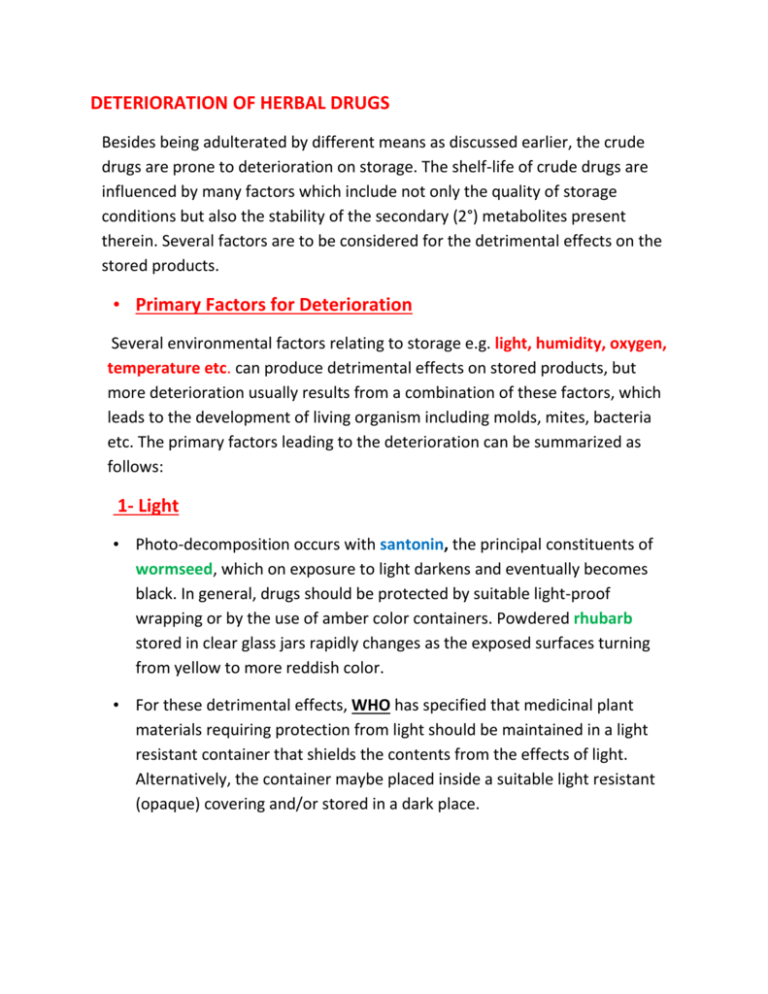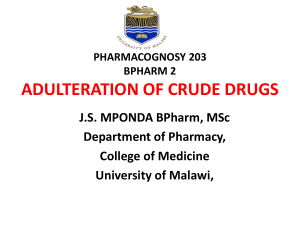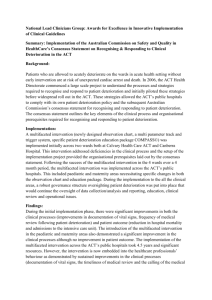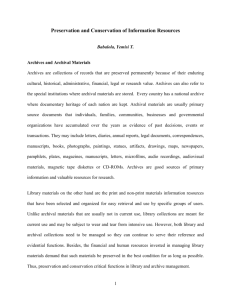Primary Factors for Deterioration
advertisement

DETERIORATION OF HERBAL DRUGS Besides being adulterated by different means as discussed earlier, the crude drugs are prone to deterioration on storage. The shelf-life of crude drugs are influenced by many factors which include not only the quality of storage conditions but also the stability of the secondary (2°) metabolites present therein. Several factors are to be considered for the detrimental effects on the stored products. • Primary Factors for Deterioration Several environmental factors relating to storage e.g. light, humidity, oxygen, temperature etc. can produce detrimental effects on stored products, but more deterioration usually results from a combination of these factors, which leads to the development of living organism including molds, mites, bacteria etc. The primary factors leading to the deterioration can be summarized as follows: 1- Light • Photo-decomposition occurs with santonin, the principal constituents of wormseed, which on exposure to light darkens and eventually becomes black. In general, drugs should be protected by suitable light-proof wrapping or by the use of amber color containers. Powdered rhubarb stored in clear glass jars rapidly changes as the exposed surfaces turning from yellow to more reddish color. • For these detrimental effects, WHO has specified that medicinal plant materials requiring protection from light should be maintained in a light resistant container that shields the contents from the effects of light. Alternatively, the container maybe placed inside a suitable light resistant (opaque) covering and/or stored in a dark place. 2- Moisture/Humidity Moisture present in drugs depends largely upon the amount of moisture in the atmosphere, which is usually expressed in the terms of humidity. When the atmosphere is completely saturated, the humidity is 100%, when half saturated it is 50% and so on. Drugs stored in non-airtight containers are termed air-dry and contain about 10-12% of water depending on the humidity of the atmosphere. This amount of water is sufficient to activate the enzymes present in some dried plant materials, such as Digitalis and bring about the decomposition of the active glycosides. Such drug should therefore be stored with a dehydrating agent or in sealed containers immediately after drying. Squill contains a hygroscopic mucilage and the powder therefore, if exposed to the atmosphere, will pickup moisture and become a sticky mass. Therefore strict humidity control is necessary while storing; low moisture may be maintained, if necessary by the use of desiccant in the container provided that direct contact with the product is avoided. 3- Temperature It has a marked effect which is sometime unsuspected. Many enzymatic changes in the plant secondary metabolites proceed more rapidly at the slightly raised temperature up to about 45°C. Obviously those drugs containing volatile constituents in unprotected structures, e.g. plants belongs to Labiatae family and the petals of rose and chamomile all loose oil with an increase in temperature. Absorbent cotton wool contains a small amount of fatty material which is the residual component from the natural fiber. At a raised temperature this molecules become re-orientated, spreading themselves over the surface of the fiber to form an impervious layer. Thus cotton wool, ones fully absorbent will gradually become completely non-absorbent because of the effect of temperature. 4- Airic Oxidation Direct oxidation of the constituents of crude drug is sometime brought about by the oxygen of the air, e.g. Linseed oil rapidly become resinified as like the oil of Turpentine and oil of Lemon. Usually this conversion is applied to the essential oil with terpenoid derivatives and we can find the resinous deposit build-up around the stoppers used in dispensing bottle containing this oil. Beside this, the rancidification of fixed oils e.g. cod-liver oil, which involves the formation of unstable peroxides, is also an oxidative process. Thus, these types of materials require storage in a well-filled, airtight container. Secondary Factors for Deterioration • Living organisms usually develop in stored drugs where the conditions are satisfactory for them. From a hygienic point of view, such contaminated material should be destroyed irrespective of whether or not the active principles of drug have been effected. The more common of such organisms belongs to the groups of bacteria, moulds, mites, nematodes, worms, insects etc. 1- Bacteria and Moulds • Dried herbs are particularly liable to be contaminated with the spores of the bacteria and moulds, which are always present in the air. Under satisfactory storage conditions their presence causes no problem, but it is generally accepted that the viable count permissible for crude drugs should be the same as that for the food stuff. The effect produced by bacteria are not always very visible with the exception of some chromogenic species of bacteria, e.g. Bacillus prodigious, which produced red patches in starchy materials. However, bacterial growth is usually accompanied by the crude drug by growth of moulds whose presence is quickly evident by the characteristic smell and by the mass of clinging particles entrapped in the mycelial hyphae. • Dusty cotton wool, which is formed by bacterial attack causing the trichomes to break into short length, rendered it to be very brittle. In order to identify a particular mould or bacteria, which is proliferating in a stored product, it is necessary to culture it on a suitable medium with a view to obtain fruiting bodies for examination. However, if the drug to be examined is infested rapidly, then it may be possible to make microscopical preparation directly from the sample. Usually the moulds encountered with poorly stored drugs include the genera Mucor (e.g. grey mould, M. mused), Rhizopus (e.g. black mould, R. nigricans), Penicillium (e.g. blue mould, P. glaucum], Aspergillus (e.g. green mould, A. repens) and Saccharomyces. 2- Mites and Nematode Worms • If found in stored drugs, mites are usually present in countless numbers upto 1.0 mm in length. Different mites found usually include Tyroglyphces siro (Cheese mite); Aleurobius farinae (Flour mite) and Glycyphagus spinipes (Cantharides mite). All these mites can examined microscopically by clearing the sample of powder containing them with chloral hydrate reagent. The best known examples of nematode worms are "Vinegar eel" Turbatrix aceti, Anguillula aceti, Anguina tritici which are found in wheat flour or in the crude drug containing starchy materials. These worms are visible to the unaided eye as minute threads continually curling and twisting in the medium they inhabit. 3- Insects/Moths • A few species of the Lepidiptera attack the stored crude drugs and cause damage at the larval stage, where the infestation can spread rapidly due to the mobility of the adults. The moths involved are unspectacular in appearance, 22-30 mm in length with off-white wings e.g. Ephestia kuehniella (Flour moth); E. ellutella (Cocoa moth). Besides this some other insects, cockroaches, ants and others are sometimes found to cause deterioration to the stored products. 4- Coleoptera or Beetles • These are the insects that constitute the largest order of the animal kingdom comprising about 2,50,000, species of which about 600 have been found to be associated with stored food product or drugs. Stegobium paniceum is one beetle, which is found in many drugs including gentian, liquorice and rhubarb as well as leafy drugs and seeds. Belonging to the same family is Lasioderma serricorne (tobacco or cigar beetle) which is reddish brown in colour, 2 to 2.5 mm in length and found in many stored crude drugs including ginger and liquorice. CONTROL MEASURES FOR DETERIORATION • The container used for storage and its closure must not interact physically or chemically with the material within in any way which would alter its composition. A well closed container must protect the contents from extraneous matter or from loss of the material while handling and a tightly closed container must protect the material from efflorescence, deliquescence or evaporation under normal condition of handling or storage. Storage area should be kept clean and spillages not allowed to enter cracks or in accessible crevices. Periodic spraying of the premises with insecticides will help to prevent the spread of infestation. • The principles, which apply to the control of infestation in warehouses, are equally applicable to small-scale storage. Good house keeping is utmost essential. Each stock should be inspected regularly and the material found to be contaminated is best to be destroyed by burning. In this respect a quick turn over to eliminate the effects of deterioration due to both the primary and secondary factors as mentioned above are desirable. • Cool, dry condition is the most suitable for the retardation of living organisms. As all leaves organisms require water for the development, perfectly dry drugs should be immune from secondary deterioration. Sometimes the crude drugs purchased by the herbalist may already have been sterilized, which is most commonly achieved by treatment of the bulk consignment with ethylene oxide or methyl bromide under controlled conditions. Drugs so treated, should comply with an acceptable limit for toxic residues e.g. for Senna pods 50 ppm of ethylene oxide is the limit.







